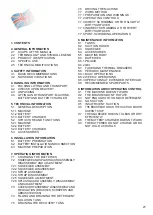
26
PHOTO B
10 HOUR METER
11 SUCTION HOSE INSPECTION CAP
12 WATER OUTLET ADJUSTING LEVER
13 BATTERY CHARGER CONNECTOR
14 RECOVERY TANK INSPECTION PLUG
15 SOLUTION TANK DRAIN PLUG
16 BRUSH PLATE LIFT/LOWER PEDAL
17 RECOVERY TANK DRAIN HOSE
18 SQUEEGEE LIFT/LOWER LEVER
19 FORWARD/REVERSE TRACTION HANDLE
20 BRAKE LEVER
21 EMERGENCY BUTTON SWITCH
PHOTO C
22 BATTERY POWER TEST
23 GENERAL ON / OFF KEY
24 BRUSH MOTOR THERMAL BREAKER
25 TRACTION MOTOR THERMAL BREAKER
26 SUCTION MOTOR SWITCH
27BRUSH MOTOR SWITCH
28 FORWARD/REVERSE SELECTOR SWITCH
PHOTO D
29 SQUEEGEE BUMPER WHEEL
30 SQUEEGEE WHEEL
31 SQUEEGEE PRESSION ADJUSTING SCREW
32 SQUEEGEE FIXING KNOB
33 SQUEEGEE INCLINATION ADJUSTING KNOB
34 SQUEEGEE BLADES REPLACEMENT KNOB
35 SUCTION HOSE
PHOTO E
BATTERY CONNECTION DIAGRAM
PHOTO F
36 BATTERY COMPARTMENT WITH 6V BATTERIES
37BATTERY CONNECTION DIAGRAM
5.2.2 BATTERY
If supplied, the Pb-Acid (if not dry charged) or gel
batteries are ready to be installed:
Positive pole - red
Negative pole - black
5.2.3 BATTERY CHARGER
If supplied, refer to the corresponding booklet.
5.3 ACCESSORIES
Your machine supplier can provide a complete and
updated list of all available accessories, such as brushes,
scrapers, disks, etc.
6. INSTALLATION INFORMATION
6.1 BATTERY PREPARATION
The technical features of the batteries used must
match those indicated in the technical features section.
Using different batteries may cause serious damage to
the machine or may require them to be charged more
frequently.
During installation or when performing any type of
battery maintenance, the operator must be equipped
with adequate safety accessories to prevent accidents.
Work far from open flames, do not short-circuit the
battery poles, do not generate sparks and do not smoke.
The batteries are normally supplied full of acid solution
(for the Pb-Acid type) and ready for use. In any case,
follow the steps indicated in the manual supplied with
the battery and carefully follow the instructions regarding
safety and operating procedures.
6.2 BATTERY INSTALLATION AND PREPARATION
These operations must be carried out by specialised
personnel.
Disconnect the Anderson connector of the battery wiring
from the Anderson connector of the machine wiring.
Always hold the connectors with the hands and never
pull on the cables.
Attach the battery wiring to the battery, connecting
the terminals only on the poles marked with the
same symbol (red wiring +, black wiring -)! A
battery short-circuit may cause an explosion!
After checking that all the controls on the panel (PHOTO
C - E) are in position 0 or at rest, connect the battery
connector to the machine connector.
Close the battery compartment making sure not to
crush any wires.
6.3 MACHINE PREPARATION
Before starting to work, wear non-slip shoes, gloves
and any other personal protection device indicated by
the supplier of the detergent used or considered
necessary based on the operating environment.
Do the following before starting to work. Refer to
the relative sections for a detailed description of these
steps:
heck the battery charge level and charge, if necessary.
Mount the brushes or scraper disks (with the abrasive
disks) that are suitable for the surface and work involved.
Mount the squeegee, check that it is solidly attached
and connected to the suction hose and that the drying
straps are not too worn.
Make sure that the recovery tank is empty. If not, empty
it completely.
Check and completely close the detergent solution
release control.
Fill the detergent solution tank with a mix of clean water
and non-foaming detergent in an adequate concentration
through the anterior hole. Leave 2 cm between the
mouth of the plug and the level of the liquid.
To avoid risks, become familiar with the machine
movements, carrying out test runs on a large surface
without obstacles.
To obtain the best results in terms of cleaning and
equipment service life, you should do the following
simple but important operations:
- Identify the work area, moving all possible obstacles
out of the way; if the surface is very extensive, work in
contiguous and parallel rectangular areas.
- Choose a straight work trajectory and begin working
from the farthest area to avoid passing over areas that
have already been cleaned.
Summary of Contents for KF66B
Page 2: ...FOTOGRAFIAS pag 3 PICTURES ESPANOL pag 8 ENGLISH pag 21 2 GB E...
Page 3: ...3 A...
Page 4: ...4 B...
Page 5: ...5 C...
Page 6: ...6 D...
Page 7: ...7 E...
Page 36: ...3 A B SWIFT 43E...
Page 37: ...3 A B SWIFT 43E...
Page 40: ...cod 7 504 0137 01 2009...





























